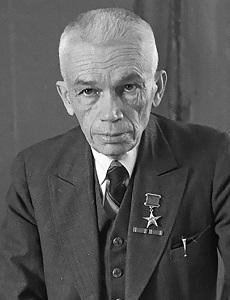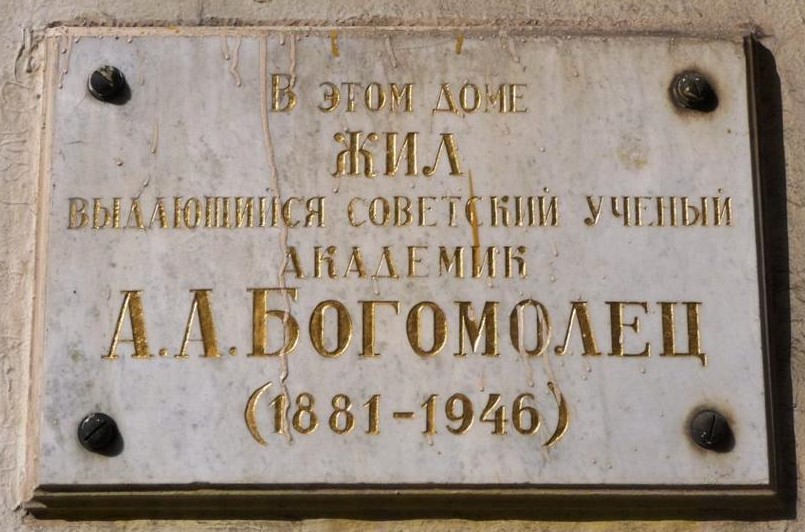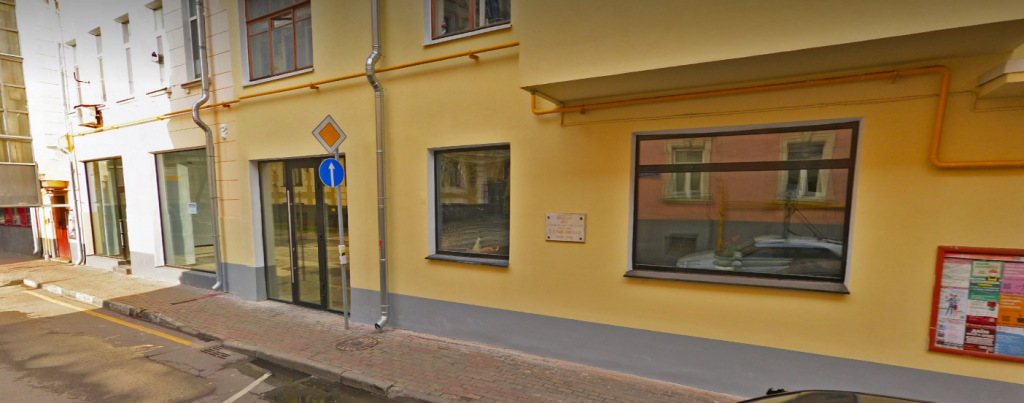Aleksander Aleksandrovich
Bogomolets
1881-1946

Aleksander Aleksandrovich Bogomolets was a pathophysiologist, the Vice-President of the USSR Academy of Sciences, President of the Academy of Sciences of the Ukrainian SSR, Director of the Institute of Experimental Biology and Pathology of the Academy of Sciences of the Ukrainian SSR, Director of the Institute of Clinical Physiology of the Academy of Sciences of the Ukrainian SSR, Academician of the Academy of Medical Sciences of the USSR, Academician of the Academies of Sciences of the USSR, Ukrainian SSR and Belarusian SSR. He was born in Kiev, in the Lukyanovka prison, where his mother, political prisoner Sophia Bogomolets, was imprisoned at that time, sentenced to 18 years of hard labor, and his father, Aleksander Mikhailovich, a zemstvo doctor, was convicted of participating in the revolutionary movement to exile in Siberia for 7 years. Before returning from his father’s exile, the boy was brought up in his grandfather’s ancestral estate in Nizhyn (now it is the Chernihiv region). In 1900 Aleksander Bogomolets graduated from the 1st Kiev Gymnasium with a gold medal and entered the Law Faculty of St. Vladimir University (Kiev University), but in the same year transferred to the medical faculty. For health reasons in January 1901 he moved to Odessa, where he continued his studies at the Medical Faculty of Novorossiysk University. During his second year at the University, Bogomolets published his first scientific work “On the structure and microphysiology of the Brunner glands” (1902). In January 1911 Bogomolets was sent abroad for one year to prepare for a professorship, worked in the best clinics and universities in France and Germany. On his return in the same year he was appointed as the Extraordinary Professor of the Department of General Pathology and Bacteriology of the Medical Faculty of the Imperial Nikolaevsky University (now it is Saratov University). Bogomolets created a scientific laboratory at Saratov University and equipped it with the best equipment of that time. He brought some of the devices from Paris, and designed some himself. The Saratov laboratory of A.A. Bogomolets had become the leading center of experimental work in the field of pathological physiology in Russia. Bogomolets’ scientific activity focused on the problems of immunology, the study of the mechanisms of cellular and humoral immunity and anaphylaxis. After the October Revolution, Professor Bogomolets became a senior epidemiologist of the Saratov Provincial Health Department. During the Civil War, he was a scientific consultant to the Sanitary Department of the Southwestern Front of the Red Army and the sanitary department of the Volga Railway Administration. In 1923 A.A. Bogomolets organized the country’s first antimalarial laboratory, which worked effectively in the Saratov Transvolga region. In March 1925 A.A. Bogomolets moved to Moscow, as he was elected as the professor at the Department of Pathological Physiology of the Medical Faculty of the 2nd Moscow State University. At the same time, in 1928-1931 A.A. Bogomolets was the director of the Institute of Hematology and Blood Transfusion of the Academy of Sciences. There, under his leadership, the problem of reliable blood preservation was solved for the first time. In 1930 Bogomolets once again abruptly changed his life and moved to Kiev. He was elected as the President of the Academy of Sciences of the Ukrainian SSR. Simultaneously from 1930 he was the Director of the Institute of Experimental Biology and Pathology and the Institute of Clinical Physiology of the Academy of Sciences of the Ukrainian SSR (now both institutes are named after Academician Bogomolets). The works of the Pilgrim in the Kiev period of life were devoted to the most important issues of pathological physiology, endocrinology, the autonomic nervous system, the teachings of constitutions and diatheses, oncology, physiology and pathology of connective tissue and problems of longevity. A major and controversial achievement of the scientist was the method he developed for influencing connective tissue with antireticular cytotoxic serum (ACC, or Worshiper serum). Bogomolets carefully developed this serum and sought to find it widely used in the fight against aging, as well as for the treatment of a wide variety of diseases. During the Great Patriotic War, the ACS was essentially the only domestic tool used to accelerate the processes of fracture fusion and healing of damaged soft tissues. As the President of the Academy of Sciences of the Ukrainian SSR, Bogomolets had done a lot of work on the development and implementation of research plans to solve the problems of industrialization of the country. In addition, he proved himself to be a man of great civic courage. Thus, during the years of mass repression, at his request and under the personal guarantee offered by him, a number of major scientists were released from prison. At the beginning of the war, together with the Academy of Sciences of the Ukrainian SSR, he was evacuated to Ufa, and all major Ukrainian institutes were taken there. He carried out a massive reorganization of Ukrainian science for the needs of wartime, which allowed him to achieve outstanding results, played a big role in the development of the defence industry. He himself continued to work in the field of pathophysiology in relation to military medicine. Since 1942 he was the Vice-President of the USSR Academy of Sciences. He was an active associate of Academician N.N. Burdenko in the creation of the Academy of Medical Sciences of the USSR.
Address: Moscow, Sivtsev Vrazhek lane, 4

